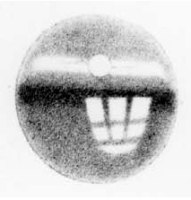They say it’s only by being wrong that we learn what’s right, and in the field of forensics, scientists had to learn the hard way that you can’t catch criminals by taking out eyeballs.
The working theory was that the human retina could capture the last thing a person saw by locking it in photosensitive pigments, and that developing their final moments could even reveal a killer. It didn’t work, unfortunately, but that didn’t stop criminal investigations trying it out on the victims of some of history’s most infamous serial killers.
It all began when a 17th-century Jesuit priest named Christoph Scheiner said he’d spotted a faint image on the retina of a dissected frog. The idea that the retina could store an image in this way became known as optography, and it was something German physiologist Wilhelm Friedrich Kühne liked the sound of when he began his own research in the 1870s.
Kühne began conducting experiments with rabbits and frogs in which he’d expose them to bright images before killing them and taking out their eyeballs. He then cut them open and used a chemical solution to fix the photosensitive pigment rhodopsin that’s found in the rods of the retina. The goal was to create an optogram showing what the poor animal had seen just before it died.
“Intriguingly, one optogram appeared to show a barred window that a rabbit had been forced to stare at,” explained medical historian Dr Lindsey Fitzharris in a clip from her Smithsonian Channel series The Curious Life and Death Of…. “The Victorians quickly latched on to the idea that optography could be used as a tool in forensic investigations and an image of the murderer’s face could be found burned into the eyes of the hapless victim.”
It might sound like science fiction to us humans in the modern era where so many are obsessed with true crime, but it seems the idea was taken quite seriously at the time, and not just by scientists.
“Murderers even began destroying their victims’ eyeballs just in case,” added Fitzharris.
Kühne tried to recreate the success he’d seen with the rabbit eye in a human one, using his technique to create an optogram from the eyes of a convicted and executed murderer. However, the resulting image lacked sufficient definition to be useful, which may come down to a significant difference between rabbit and human eyes.
“A possible explanation lies in the fact that in humans, the focal point of the retina, the fovea centralis, is only 1.5 mm [0.06 inches] in diameter and too small for observing an optogram,” explained Dr Howard Fischer in Hektoen International, a journal of medical humanities. “It is larger in frogs and rabbits.”
Do you see a window in this optogram of a rabbit’s retina?
In 1881, one of Kühne’s former colleagues had a stab at human optography, but their results were also too indistinct to be useful. The repeated lack of success didn’t kill optography just yet, however, as later attempts tried creating optograms by taking photographs of dead people’s eyeballs.
In 1888, police may also have tried taking an optogram of murder victim Mary Jane Kelly in the hope it just might reveal the face of serial killer “Jack The Ripper”, but if it was carried out, it was to no avail. An optogram was also submitted as evidence in a 1914 murder case, reports the American Academy Of Opthalmology.
You won’t find optograms being submitted as forensic evidence today, but the idea has remained very popular in science fiction. From one condemned rabbit’s view of a barred window to some of history’s most infamous serial killers, and the plot of Lambert Hillyer’s The Invisible Ray, it’s been quite the journey for an idea born in the eyeball of a dissected frog.
Source Link: Forensic Optography: Could Retinas Really Preserve The Last Thing A Victim Saw?
